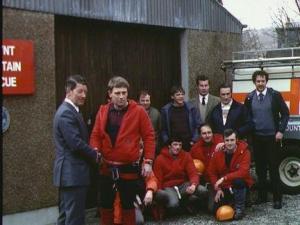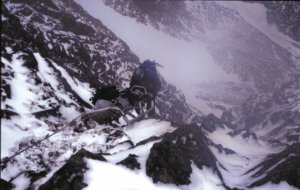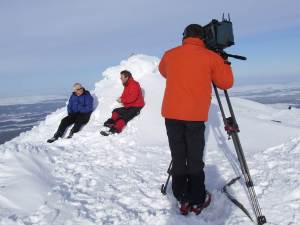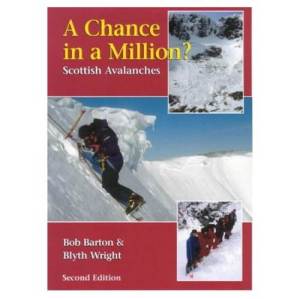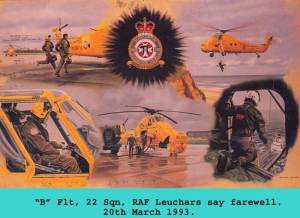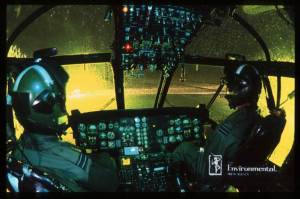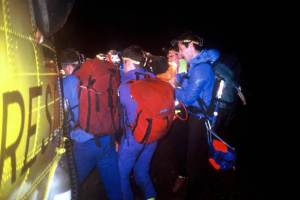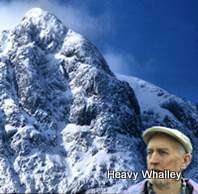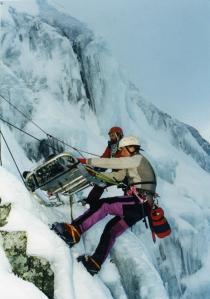When I was the Team Leader at RAF Leuchars in the late 80,s I worked with the then Assynt Team Leader Phil Jones we became good friends. We shared ideas and thoughts on training and I was impressed how this team with such a huge area and a small team that was so diverse worked . We became good friends and spent time on the hill together and climbed a few routes. We had a wee epic on the Fiddler’s nose and he showed me many secret crags. When we were up in Lochinver it was always a good night and Phil became a very good friend of the Team. I was running our annual RAF Winter Course in Feb 1991 at Grantown On Spey when a message came through that their had been an accident to a MRT on Seanna Bhraigh . This was in the days before mobile phones and the news spread like wildfire through the Rescue community. It was a huge shock everyone and I was devastated when I was told it was Phil had been killed in an accident whilst training with the Assynt Team. Phil had been caught in a slab avalanche it was to be a tragic time for the Phil’s family and the team. This reinforced the seriousness of the Mountain Rescue even in training and the need for Insurance for all team member’s whilst training or on a call -out. This was to take many years to ensure that all teams were treated the same by the Insurance companies.
These years in the 1990’s were extremely interesting in Mountain Rescue huge lowers on the big cliffs with lessons learned from previous years became a lot more regular. One of the stalwart of these years was “Nevis Mick ” of Lochaber Mick Tighe a local British Mountain Guide who reckons over his period in Lochaber MRT that he “did a quick reckoning and it seems I’ve done 30 odd big lowers on the Ben, Creag Meaghaidh and one on Skye!” Incredible!
Increase again in Stats – Mountaineering exploded in this period and with it the Mountain Rescue incidents in 1999 rising to – 323 incidents – with 30 fatalities, mobile phones were starting to be used on rescues. The press became much more interested and on the big call -outs and searches there was regular Media interest.
Rescue was a 13-part Documentary series created and directed by Cameraman Paul Berriff. It focused on the work of “Rescue 137”, a Sea King belonging to 2012 Sqn RAF SAR in and around their base at RAF Lossiemouth, Scotland over a period of a year between 1988 -1989.
The series covered a multitude of incidents ranging from ferrying a sick child to hospital, mountain rescue incidents right up to the world’s worst offshore disasters, the explosion and ensuing fire on the Piper Alpha oil platform.
STV has upload all the episodes, with the exception of “Piper Alpha” to the STV Player YouTube channel: http://www.youtube.com/show/rescue This was to show Mountain Rescue in various incidents .
Media Changes – This was noted after Lockerbie in 1988 and a few did a Media Skills Course to try to give a more professional insight into Rescue. The Police still had the responsibility but the media wanted Mountain Rescue in put many vital lessons were learned. A few teams wanted little to do with the Media but in time we have learned to work together and many lessons learned. A few went badly wrong like the call out for Jackie Greaves in the Cairngorms where MOD released a RAF team video that caused mayhem throughout Mountain Rescue.
Avalanches – During this period was also the Black Winter of 1994 – 1995 . Twelve died on the Scottish Mountains in various avalanches all over Scotland.
These accidents were all over Scotland 1 in Torridon, 1 Lochnagar, 1 Creag Mheagaidh, 6 Glencoe,2 Cairngorms and 1 on White Comb in the Borders. This was a tragic period for teams involved. A few casualties were not found for several weeks. Teams were now purchasing avalanche transceivers and avalanche rescue equipment and its use was part of the team’s training.
This is well written about in the book A Chance in a Million by Blyth Wright & Bob Barton there is a chapter on the ” Black Winter” a must read for all winter walkers/ climbers and skiers. Even the very experienced as this period spells out in the book can have fatal accidents. The Avalanche daily reports were now increased to 5 areas . Lochnagar,Cairngorms, Lochaber, Glencoe, Creag Mheagaidh and many used this daily along with the free Mountain Weather Forecast that were available.
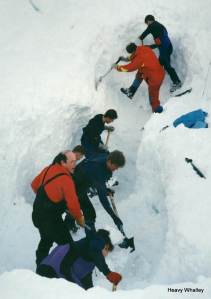
The huge effort by Glencoe, Lochaber, SARDA and the RAF Teams looking for the family of 3 that were avalanched on the Buachaille Etive Mor – A very sad period.
During this era we said farewell to the “Mighty Wessex” it was phased out and various changes took place in the SAR Helicopter locations. When the last Wessex flew from RAF Leuchars in Fife it was a sad day and an end of an era.
These incredible helicopters and their crews were at the forefront of many operations in Scotland and are still today thought of with great love and affection.
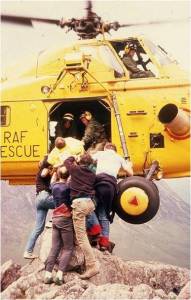
The Glencoe Team in a difficult situation load a casualty on to the Wessex, what a great machine and crews. Photo Glencoe MRT.
Change has to happen and we were lucky as many crews went on fly the Sea King helicopters that were stationed at RAF Lossiemouth in Morayshire and the Royal Navy Sea Kings at RNAS Gannet at Prestwick. This bigger aircraft meant it could transport the more of team members to incidents and was to be a great SAR assett like the Wessex for many years ( up to 2015) The Sea King was now the main aircraft and by now all the teams were happy working with it. We all got used to the increased downdraught but loved this aircraft as much as the Wessex. When Night Vision Goggles came in we spent a few wild nights training to get things rights as a night pick up or drop off is interesting to say the least. This meant that in certain conditions the Sea King could fly at night and it was a new world for us all travelling around these great mountains in the dark and landing to assist a fallen or lost walker.
When this great beast came in at night on night vision goggles it was interesting. All our lights were off and this beast would land near by with a wind blowing everything about from the rotors. This massive aircraft above your head was interesting especially for the casualty who was strapped in to the stretcher!
Teams were by now full on with many Rescues occurring. There was an incredible call -out in Skye in 1995 on May 6-8 th where two climbers had been stuck on the Fluted Buttress on the Coireachan Ruadh Face of Sgurr MhicConnich, Their ropes jamned whilst abseiling down the East Face near O’Brians and Julians Climb. Word came out by boat that they were missing from the Coruisk Hut. They were not located for two days the weather was awful with fresh snowfall. It was an incredible effort by one of the Skye team who climbed up to the casualties, we had never seen such a lead in the pouring rain and snow . It was the bravest thing I have ever heard off in all my years in Rescue. There was no way due to rock fall you could come in from above, so he had to climb up to the casualties, Unfortunately only one climber survived but this tragedy showed many of us that despite the improvement in helicopters gear and equipment it is still essential to have mountaineers who are able to climb to the casualties and attempt a rescue. In addition it took lots of manpower to take the casualties off not easy on the other side of the Skye ridge.
| c | |||||||||
| 96.
4th Mar |
Cairngorm | Coire an Lochan | 0 | 2 | yes | t | |||
| 95.
5th/6th Mar |
Southern Uplands | White Coomb | Solo walker found in avalanche he had been swept down 60 metres, by Cornice collapse in thaw. | 1 | 0 | 1 | yes | t | c |
| 94.
30th Dec |
Northern Highlands | Beinn Eighe Spidean Coire Nan Clach | Three walkers avalanched on open slope 50 metres below the summit. Snow slab off and they fell 80 metres. | 0 | 2 | 4 | no | t | |
| 1995 | Incidents | 12 | 12 | 22 | 48 |

